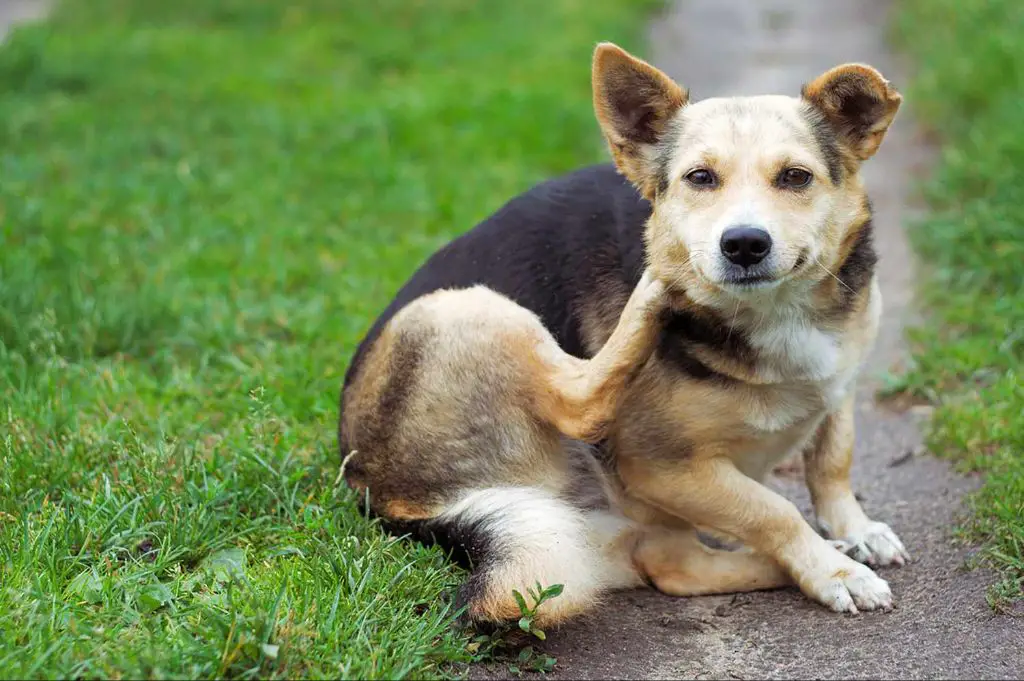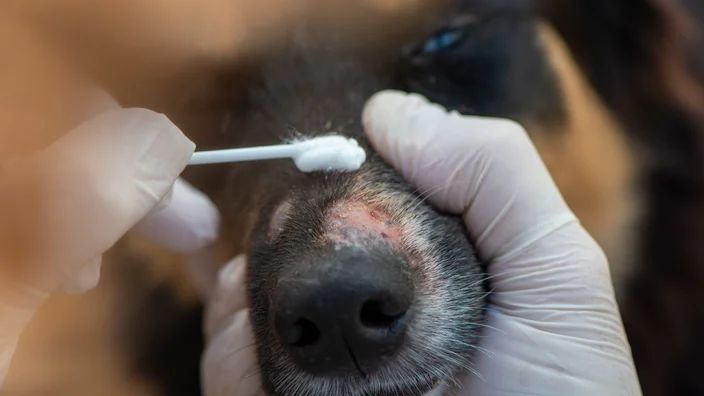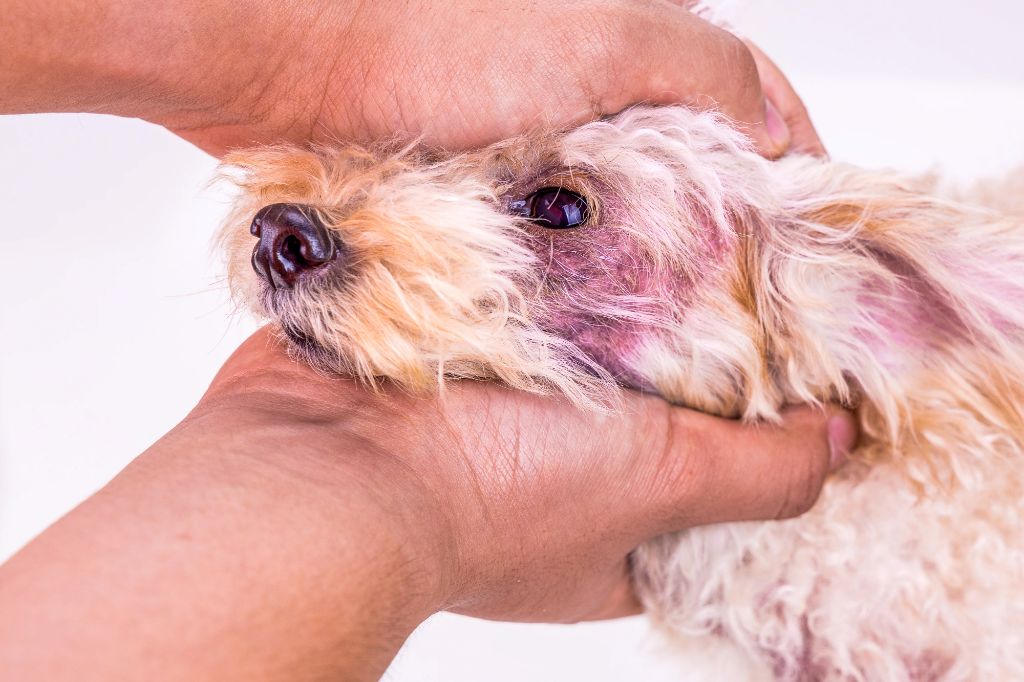Introduction
Fungal infections in dogs can cause a variety of symptoms, ranging from skin irritation to respiratory distress. One common question many dog owners have is whether fungal infections cause any noticeable odors. The short answer is yes – some types of fungal infections in dogs can produce strong, unpleasant smells.
The musty, yeasty smell of a fungal infection comes from the overgrowth of fungus on the dog’s skin, ears, or internal organs. Fungi release volatile organic compounds as part of their natural metabolic processes, and these compounds produce the characteristic fungal odor. The intensity of the smell depends on the location, type, and severity of the infection.
Identifying a bad smell on your dog is often the first sign of a fungal infection. Getting an accurate diagnosis and prompt treatment is important, as some fungal infections can be very serious if left untreated. In this article, we’ll explore the types of fungal infections in dogs, what causes the odor, where smells are most noticeable, and how to get a diagnosis and proper treatment for your dog.
Types of Fungal Infections in Dogs
There are several common fungal infections that can affect dogs:
Ringworm
Ringworm is a highly contagious fungal infection of the skin, hair, and nails that gets its name from the ring-shaped lesions it causes. It is caused by several types of fungi in the genus Trichophyton or Microsporum. Ringworm is transmitted by direct contact with an infected dog or indirect contact with contaminated objects or environments. Puppies and dogs with weakened immune systems are most susceptible (Source).
Yeast
Yeast infections are caused by an overgrowth of naturally occurring Malassezia yeast in a dog’s body. Allergies, an underlying medical condition, poor grooming, or a damp environment can allow yeast levels to increase leading to skin irritation and infection. Common locations include the ears, muzzle, armpits, groin, and paws (Source).
Aspergillosis
Aspergillosis is caused by a fungus called Aspergillus that lives in soil, plants, or rotting compost. Dogs can become infected by inhaling fungal spores into their lungs and sinus cavities. Aspergillosis can spread to other organs. A chronic cough, difficulty breathing, and nasal discharge are common symptoms (Source).
Causes and Transmission
Fungal infections in dogs can be caused by exposure to fungi commonly found in the environment or through contact with other infected dogs. According to Merck Veterinary Manual, dogs can acquire fungal infections through inhalation, ingestion, or contact with skin, such as through a cut or wound. Fungi are present in soil, plants, food, and indoor environments, so dogs can pick up fungal spores as they explore their surroundings.

Transmission between dogs often occurs when an infected dog comes into close contact with a healthy dog. Fungal spores can spread between dogs sharing living spaces through direct contact or by contaminating shared items like food bowls, bedding, and toys. Grooming and other close interactions provide opportunities for fungi on an infected dog’s skin, fur, or paws to transfer to a healthy dog. According to VCA Hospitals, fungal infections easily spread in settings like kennels, dog parks, shows, and daycares where dogs mingle in close proximity.
Locations on a Dog’s Body
Fungal infections can occur on various parts of a dog’s body, but some of the most common locations include:
Skin
A dog’s skin contains yeast and bacteria that live in balance. When that balance is disrupted, the yeast can overgrow leading to fungal infections like yeast dermatitis. This causes inflamed, itchy skin with a rash or red bumps 1.
Ears
Dogs with floppy ears are prone to ear infections since moisture and wax can build up inside the ear canal. Yeast like Malassezia is commonly involved in ear infections, causing inflammation and bad odor 2.
Paws
The paws can pick up fungal spores from the environment leading to infections between the toes or on the pads. This causes itching, redness, and hair loss 3.
Symptoms
The most common symptoms of fungal infections in dogs are related to skin and hair abnormalities. These include hair loss, redness, itching, and discoloration of the skin and coat.

Hair loss is often one of the first signs noticed by pet owners. Fungal infections can cause patchy bald spots as the infection damages and kills hair follicles. The skin in these bald patches may appear red and inflamed. Crusting and flaking of the skin may also occur.
Itching is another key symptom, as the infection irritates the dog’s skin. Dogs with fungal skin infections will excessively lick, bite and scratch at infected areas. This self-trauma can lead to further hair loss, skin damage and secondary bacterial infections.
Discoloration of the skin and coat can occur with some fungal infections. Ringworm often causes circular patches of hair loss with redness and scaling. The edges of these lesions may appear more red, while the centers can become grayish-white as the infection progresses.
While the symptoms focus on the skin and coat, fungal infections can be very uncomfortable for dogs. Paying attention to hair and skin changes can allow early diagnosis and treatment.
Do Fungal Infections Smell?
Yes, fungal infections in dogs often have a distinctive musty odor. The fungi that cause these infections release compounds that produce a characteristic smell. According to Healthline, the fungi responsible for jock itch in humans give off compounds that create a musty odor and the more severe the infection, the stronger the smell (https://www.healthline.com/health/jock-itch-smell).
Similarly, dogs with fungal skin infections like ringworm or yeast infections will emit an identifiable musty or yeasty smell from the infected areas. The odor results directly from the metabolic byproducts of the fungi accumulating on the dog’s skin and haircoat. Areas commonly affected include the paws, ear canals, armpits, and skin folds.
A strong, musty smell is therefore considered one of the classic symptoms of fungal infections in dogs. If the infected area also appears reddened, flaky, greasy, or hairless, a fungal infection should be suspected. Diagnostic tests like skin scrapings or fungal cultures can confirm the presence of fungus. Treating the infection will help resolve the odor.
While not all fungal infections may have an odor in dogs, an abnormal musty or yeasty smell is a common sign of fungal overgrowth. Paying attention to this distinctive smell can aid early detection and treatment.
Diagnosis
To accurately diagnose a fungal infection, a veterinarian will first perform a physical exam of the dog. They will look for common signs of fungal infection like hair loss, skin lesions, itching, or inflammation. The vet may also ask about the dog’s medical history and when symptoms started to appear.
One of the main ways vets test for fungal infections is by taking a skin scraping or hair plucking from the affected area. This sample can be examined under a microscope to look for evidence of fungal organisms. Fungal cultures may also be taken by lightly scraping the dog’s skin and placing the sample in a special medium to allow the fungus to grow for identification.
According to the Merck Veterinary Manual, “Diagnosis is made by identifying the fungus in tissue or fluid samples.” https://www.merckvetmanual.com/dog-owners/disorders-affecting-multiple-body-systems-of-dogs/fungal-infections-in-dogs
Once a fungal infection is confirmed through these diagnostic tests, vets can recommend the proper treatment plan for the dog.
Treatment
Treatment for fungal infections in dogs often involves using antifungal shampoos and oral medications prescribed by a veterinarian. Some commonly used shampoos include miconazole and chlorhexidine which help to treat yeast and other fungal infections on the skin and coat. These medicated shampoos are used in combination with topical creams or ointments directly applied to affected areas.
For systemic fungal infections, vets may prescribe oral antifungal medications like fluconazole, itraconazole or terbinafine. These drugs work internally to treat fungal infections affecting internal organs. The specific medication and dosage will depend on the type and severity of infection. Antifungal medication is usually given over the course of several weeks under veterinary supervision to properly treat the fungal infection.
In addition to medications, keeping the skin clean and dry can help combat fungal infections. Your vet may recommend frequent baths with an antifungal shampoo and improved hygiene practices to support medical treatment. Proper nutrition, exercise and stress reduction may also help a dog’s immune system fight off fungal infections.

While home remedies like yogurt and apple cider vinegar may provide some relief, it’s important to follow your veterinarian’s prescribed treatment plan to fully eliminate the fungal infection. Left untreated, fungal infections can worsen and lead to complications. Working closely with your vet provides the most effective way to treat fungal infections in dogs.
Prevention
There are several ways to help prevent fungal infections in dogs, with a focus on good hygiene and avoiding sharing of grooming tools:
Maintain good hygiene and grooming habits. Regularly bathe your dog and keep their skin and coat clean. Brush frequently to remove dead hair and skin cells where fungi can grow. Trim hair around eyes, ears, tail, and feet to prevent overgrowth of hair in moist areas.
Avoid sharing grooming tools and supplies between dogs. Clippers, brushes, towels, etc. can transmit fungal spores between dogs. Disinfect grooming tools after each use. Use separate grooming tools for infected dogs.
Clean bedding, bowls, collars and leashes regularly with anti-fungal shampoo. Wash kennels, crates and beds weekly. Replace bedding like blankets frequently.
Boost your dog’s immune health with good nutrition and exercise. A strong immune system can help fight fungal infection.
Keep your home and yard clean and dry. Moisture allows fungi to thrive. Address leaks, condensation, and dampness issues.

Check for signs of infection and treat promptly. Treatment can prevent spread to other pets.
Ask groomers and boarders about sanitation protocols. Ensure proper disinfecting practices are followed.
Cite: https://www.petmd.com/dog/general-health/identifying-and-treating-fungal-infections-dogs
Conclusion
To recap, some fungal infections in dogs do produce an odor while others do not. The most common fungal infections in dogs that cause a smell are yeast infections in the ears and skin folds. The yeast overgrowth emits a foul, musty odor reminiscent of corn chips. Another fungal infection called ringworm usually does not have a smell. Other fungal infections like aspergillosis and histoplasmosis affect the internal organs and also do not produce an odor.
Treatment for a fungal infection depends on the location and type of fungus. Topical antifungal creams, medicated shampoos and ear solutions are commonly prescribed for skin and ear infections. Oral antifungal medication may be used for more systemic fungal infections. Keeping areas clean and dry can help prevent fungal overgrowth. While smelly fungal infections in dogs can be unpleasant, they are very treatable if properly diagnosed and managed.